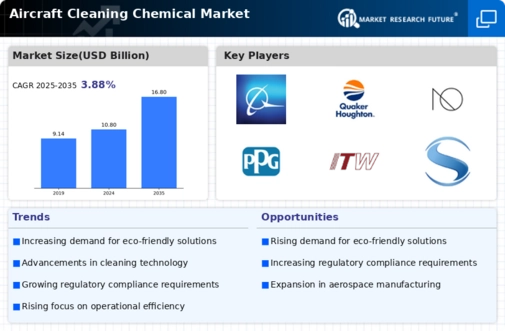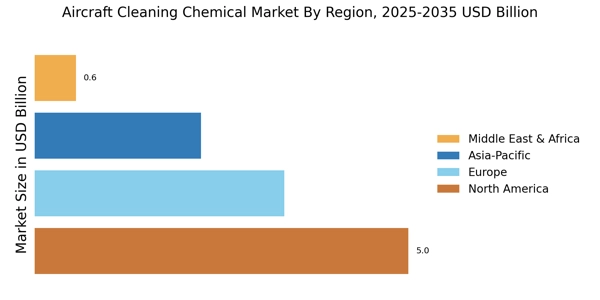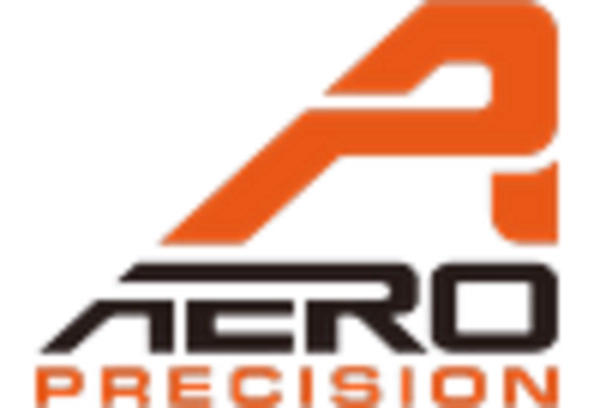Increasing Aircraft Fleet Size
The Aircraft Cleaning Chemical Market is poised for growth due to the increasing size of the aircraft fleet worldwide. As airlines expand their operations and new carriers enter the market, the demand for cleaning services and associated chemicals rises correspondingly. The global aircraft fleet is projected to grow significantly, with estimates suggesting an increase of over 30% in the next decade. This expansion necessitates a robust supply of cleaning chemicals to maintain the operational readiness and appearance of these aircraft. Consequently, manufacturers of aircraft cleaning chemicals are likely to see heightened demand, as they cater to the needs of a growing and diverse fleet.
Focus on Environmental Sustainability
The Aircraft Cleaning Chemical Market is increasingly influenced by the focus on environmental sustainability. As regulatory bodies and consumers alike demand greener solutions, manufacturers are compelled to innovate and develop eco-friendly cleaning agents. This shift is evident in the growing market for biodegradable and non-toxic cleaning products, which are gaining traction among airlines seeking to enhance their sustainability profiles. The market for environmentally friendly aircraft cleaning chemicals is expected to expand significantly, reflecting a broader trend towards sustainable practices in aviation. Companies that adapt to these preferences may find themselves at a competitive advantage, as they align with the values of environmentally conscious consumers and regulatory frameworks.
Rising Demand for Aircraft Maintenance
The Aircraft Cleaning Chemical Market is experiencing a notable increase in demand due to the rising frequency of aircraft maintenance activities. As airlines and operators prioritize safety and operational efficiency, the need for effective cleaning solutions becomes paramount. The market for aircraft cleaning chemicals is projected to grow at a compound annual growth rate of approximately 5.2% over the next few years. This growth is driven by the necessity to maintain aircraft aesthetics and functionality, ensuring compliance with safety regulations. Furthermore, the increasing number of aircraft in operation globally necessitates a corresponding rise in cleaning services, thereby propelling the demand for specialized cleaning chemicals tailored for aviation applications.
Regulatory Compliance and Safety Standards
The Aircraft Cleaning Chemical Market is significantly influenced by stringent regulatory compliance and safety standards imposed by aviation authorities. These regulations dictate the types of chemicals that can be used in aircraft cleaning processes, ensuring that they do not pose risks to human health or the environment. Compliance with these regulations is essential for airlines and maintenance providers, as non-compliance can lead to severe penalties and operational disruptions. Consequently, there is a growing demand for cleaning chemicals that meet these regulatory requirements, driving innovation and development within the market. Companies that can provide compliant and effective cleaning solutions are likely to thrive in this competitive landscape.
Technological Advancements in Cleaning Solutions
The Aircraft Cleaning Chemical Market is benefiting from technological advancements that enhance the efficacy and efficiency of cleaning solutions. Innovations such as nanotechnology and advanced surfactants are being integrated into cleaning products, resulting in superior performance and reduced application times. These advancements not only improve cleaning outcomes but also contribute to cost savings for airlines and maintenance providers. The introduction of automated cleaning systems, which utilize these advanced chemicals, is also gaining popularity, further driving market growth. As technology continues to evolve, the Aircraft Cleaning Chemical Market is likely to see a surge in demand for high-performance cleaning solutions that meet the rigorous standards of the aviation industry.


















Leave a Comment